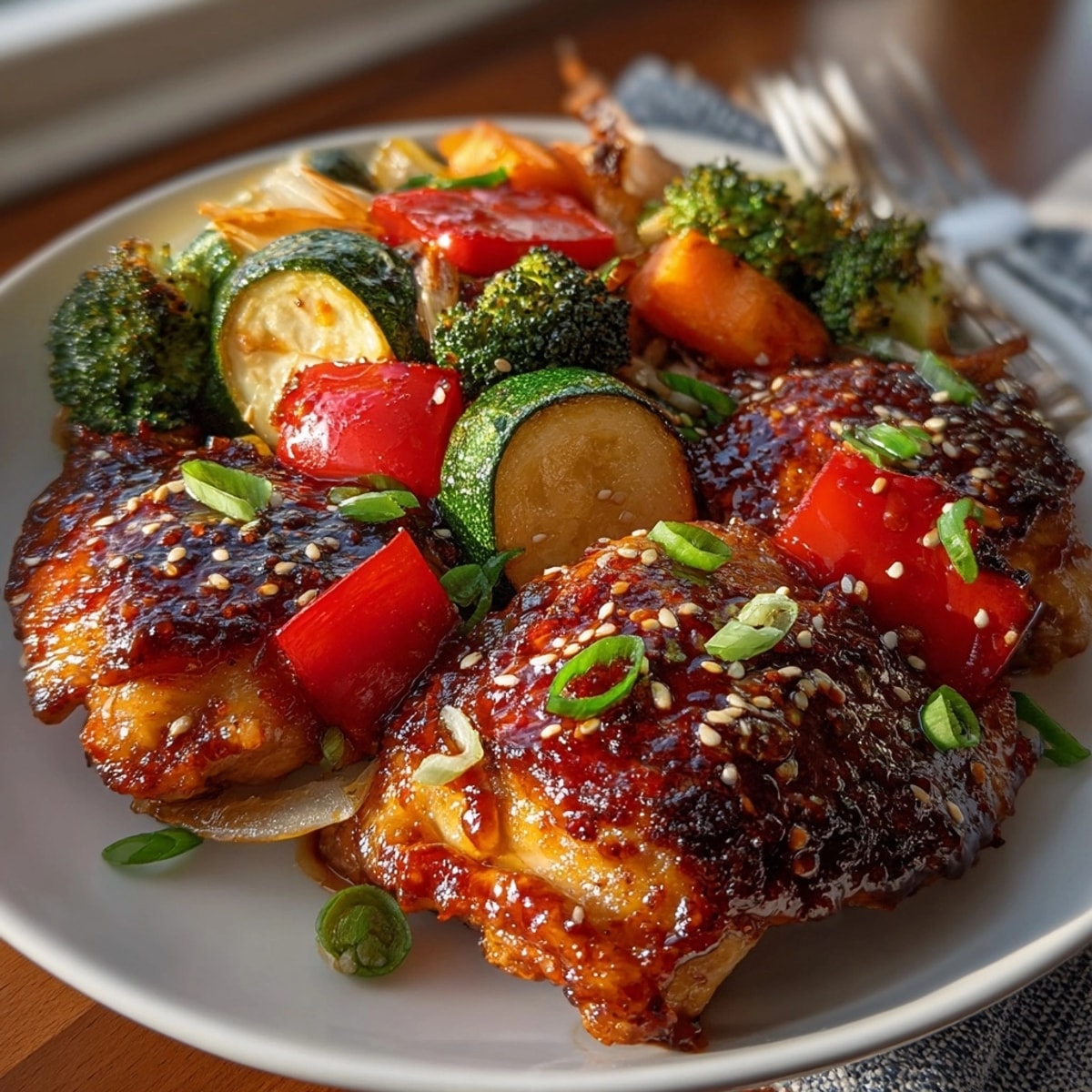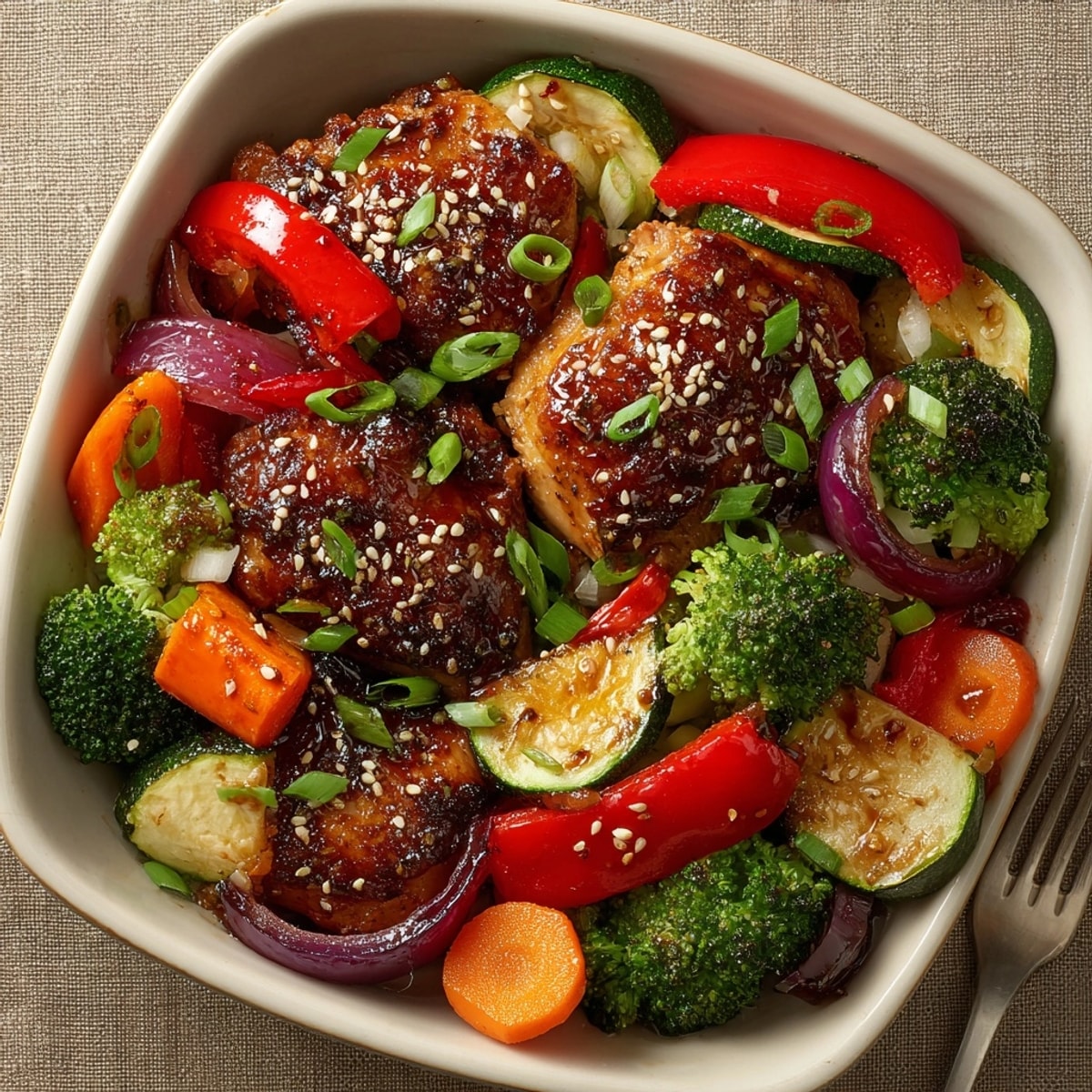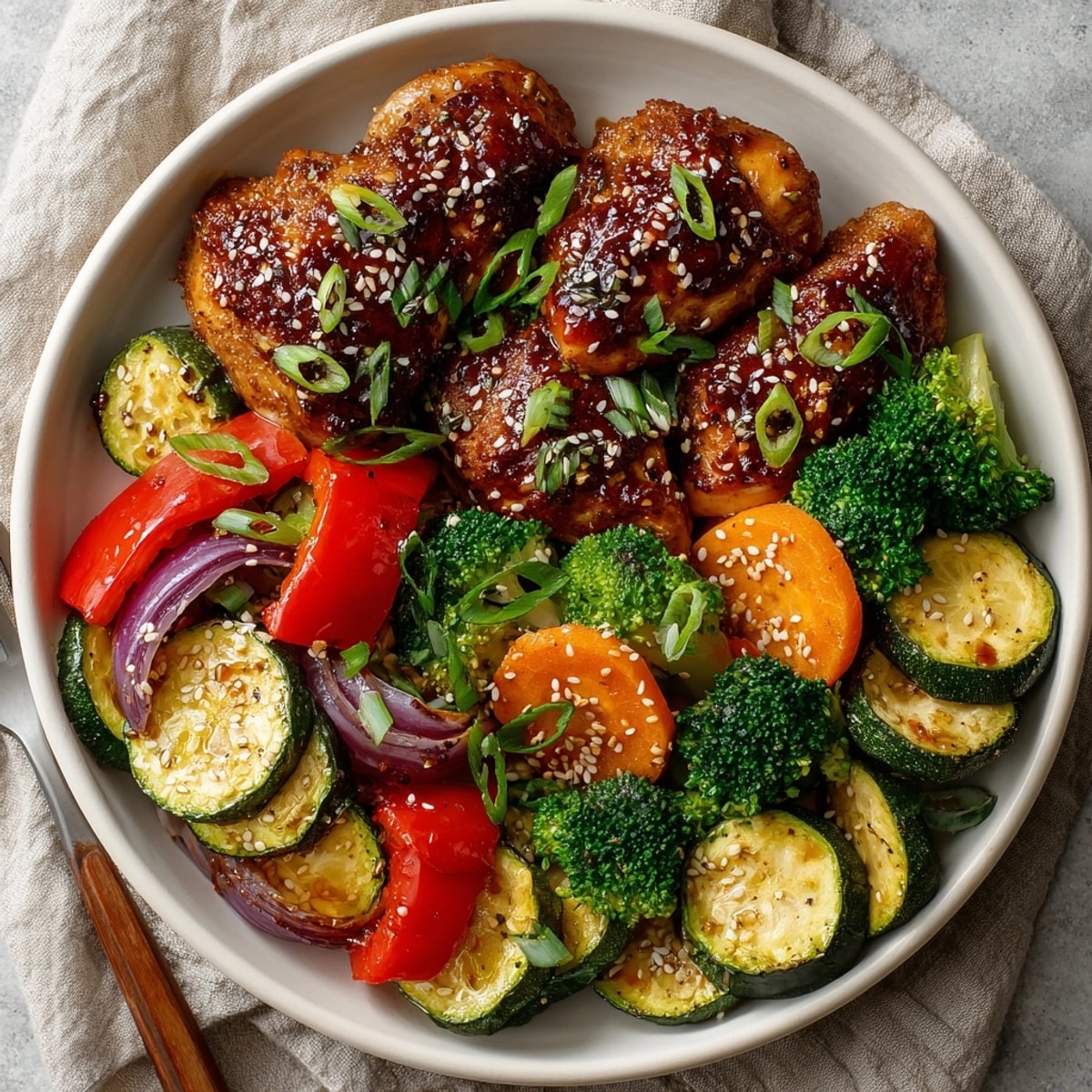 Save
Save This sheet pan Korean BBQ chicken has transformed weeknight dinners at my house, combining juicy chicken with caramelized vegetables in one easy-to-clean pan. The sweet-spicy glaze creates restaurant-quality flavor with minimal effort.
I created this recipe during a busy work week when I needed something impressive yet simple. My family was so delighted by the flavors that it's now requested at least twice a month, especially when we're craving something with bold Asian flavors without ordering takeout.
Ingredients
- For the chicken: Boneless skinless chicken thighs provide more flavor and stay juicier than breast meat. Dark meat stands up beautifully to high heat roasting
- For the chicken: Soy sauce creates the savory umami base for the marinade. Look for naturally brewed soy sauce for best flavor
- For the chicken: Gochujang Korean chili paste brings authentic flavor with moderate heat and subtle sweetness. Find it in the international aisle or Asian markets
- For the chicken: Honey balances the spice and helps create beautiful caramelization. Local honey adds wonderful nuance
- For the chicken: Sesame oil adds nutty depth that defines Korean flavors. Always use toasted sesame oil for maximum impact
- For the chicken: Fresh garlic and ginger are non-negotiable for authentic flavor. Choose firm ginger roots with smooth skin
- For the chicken: Rice vinegar provides essential acidity to balance the sweet and savory elements
- For the vegetables: Bell peppers add sweetness and color. Red bells are sweeter than green varieties
- For the vegetables: Zucchini absorbs flavors beautifully while maintaining some texture
- For the vegetables: Red onion caramelizes wonderfully in the oven, adding sweetness and depth
- For the vegetables: Broccoli florets develop delicious crispy edges when roasted
- For the vegetables: Carrots add natural sweetness and hearty texture. Look for firm, bright orange specimens
Instructions
- Prepare the oven and pan:
- Preheat your oven to 425°F and line a large sheet pan with parchment paper or foil. The high temperature ensures caramelization while the liner prevents sticking and makes cleanup effortless. Position your rack in the middle of the oven for even cooking.
- Mix the marinade:
- In a medium bowl, combine soy sauce, gochujang, honey, sesame oil, minced garlic, grated ginger, and rice vinegar. Whisk thoroughly until the honey is fully incorporated and the mixture is smooth. This creates a balance of sweet, spicy, salty and tangy flavors that will infuse into the chicken.
- Marinate the chicken:
- Add chicken thighs to the marinade, turning each piece to ensure complete coating. Allow the chicken to marinate for at least 15 minutes at room temperature. For deeper flavor development, cover and refrigerate for up to 2 hours. The longer marination allows the flavors to penetrate the meat more thoroughly.
- Prepare the vegetables:
- In a large bowl, combine bell pepper, zucchini, red onion, broccoli, and carrots. Drizzle with olive oil and season with salt and pepper. Toss thoroughly to ensure even coating. Cut vegetables into similar sizes to ensure even cooking. Slightly larger pieces work better as they won't overcook while the chicken finishes.
- Arrange the sheet pan:
- Spread the seasoned vegetables evenly across the prepared sheet pan, ensuring they're in a single layer. Nestle the marinated chicken pieces among the vegetables, leaving small spaces between items for proper air circulation. This arrangement allows heat to circulate efficiently around all components.
- Roast to perfection:
- Place the sheet pan in the preheated oven and roast for 25-30 minutes. Look for chicken that reaches 165°F internally and vegetables that are tender with caramelized edges. The chicken should develop a beautiful glaze while the vegetables take on rich color. Rotate the pan halfway through cooking if your oven has hot spots.
- Garnish and serve:
- Remove the sheet pan from the oven and sprinkle the chicken with toasted sesame seeds and sliced green onions. The seeds add nutty crunch while the green onions provide fresh, bright flavor and color. Let rest for 3-5 minutes before serving to allow juices to redistribute in the chicken.
 Save
Save Gochujang is my secret weapon in this recipe. I discovered it years ago at a Korean market and have been obsessed ever since. It adds a depth that regular hot sauce simply cannot match. The first time I served this dish to my Korean neighbor, she was impressed by how authentic the flavors were and immediately asked for the recipe.
Storage and Leftovers
This dish keeps beautifully in airtight containers in the refrigerator for up to 3 days. The flavors actually develop and improve overnight, making it an excellent meal prep option. To reheat, place in a 350°F oven for about 10 minutes until warmed through. Avoid microwaving if possible as it can make the chicken rubbery and vegetables soggy. For best results, store the chicken and vegetables separately from any rice or other sides.
Make It Your Own
While this recipe specifies certain vegetables, feel free to customize based on what's in season or in your refrigerator. Root vegetables like sweet potatoes or parsnins work wonderfully in fall and winter. In summer, try adding cherry tomatoes during the last 10 minutes of cooking. Mushrooms add wonderful umami flavor year round. Just ensure that harder vegetables are cut slightly smaller than quick cooking ones to ensure even doneness.
Serving Suggestions
Serve this colorful dish over steamed white or brown rice to soak up the delicious sauce. For a lower carb option, cauliflower rice works beautifully. For an interactive meal, provide butter lettuce leaves and let everyone create their own Korean BBQ wraps. A simple cucumber salad with rice vinegar makes a cooling side dish that balances the bold flavors. Complete the meal with kimchi for an authentic Korean experience.
Cultural Context
This recipe represents a fusion approach to Korean BBQ, adapting traditional flavors to a convenient Western cooking method. Traditional Korean BBQ typically involves grilling marinated meats at the table, but this sheet pan version captures those beloved flavors in a more accessible format. Gochujang, the fermented chili paste used in the marinade, has been a staple in Korean cooking for centuries and provides the distinctive sweet heat that makes Korean cuisine so craveable.
 Save
Save Enjoy this flavorful and convenient weeknight meal!
Recipe FAQ
- → Can I use chicken breasts instead of thighs?
Yes, chicken breasts can be used. Adjust the cooking time as they may cook faster than thighs. Check for doneness to avoid overcooking.
- → What vegetables work well for roasting on the sheet pan?
Try red bell pepper, zucchini, carrot, broccoli, and onion. Sweet potatoes, mushrooms, or snap peas are also great additions.
- → How can I make this dish gluten-free?
Use tamari or certified gluten-free soy sauce and choose a gluten-free gochujang if needed. Always check product labels.
- → Is this meal suitable for meal prep?
Absolutely. Cool the dish completely, store in airtight containers, and refrigerate up to 3 days. Reheat before serving.
- → What pairs well as a side?
Steamed rice, lettuce cups, or a crisp salad alongside the chicken and vegetables complement this dish beautifully.
- → How do I know when the chicken is done?
Chicken should reach an internal temperature of 165°F (74°C). Juices run clear and meat is tender when finished roasting.